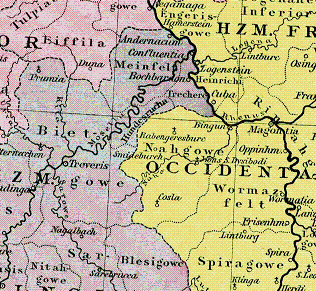Nahegau on:
[Wikipedia]
[Google]
[Amazon]
 The Nahegau was in the
The Nahegau was in the
 The Nahegau was in the
The Nahegau was in the Middle Ages
In the history of Europe, the Middle Ages or medieval period lasted approximately from the late 5th to the late 15th centuries, similar to the post-classical period of global history. It began with the fall of the Western Roman Empire ...
a county
A county is a geographic region of a country used for administrative or other purposes Chambers Dictionary, L. Brookes (ed.), 2005, Chambers Harrap Publishers Ltd, Edinburgh in certain modern nations. The term is derived from the Old French ...
, which covered the environs of the Nahe and large parts of present-day Rhenish Hesse
Rhenish Hesse or Rhine HesseDickinson, Robert E (1964). ''Germany: A regional and economic geography'' (2nd ed.). London: Methuen, p. 542. . (german: Rheinhessen) is a region and a former government district () in the German state of Rhineland- ...
, after a successful expansion of the narrow territory, which did not reach the Rhine
), Surselva, Graubünden, Switzerland
, source1_coordinates=
, source1_elevation =
, source2 = Rein Posteriur/Hinterrhein
, source2_location = Paradies Glacier, Graubünden, Switzerland
, source2_coordinates=
, so ...
, to the disadvantage of the Wormsgau
The Wormsgau ( la, pagus wormatiensis) was a medieval county in the East Frankish (German) stem duchy of Franconia, comprising the surroundings of the city of Worms and further territories on the left bank of the Upper Rhine river. Together with t ...
. Among other expansions were Ingelheim
Ingelheim (), officially Ingelheim am Rhein ( en, Ingelheim upon Rhine), is a town in the Mainz-Bingen district in the Rhineland-Palatinate state of Germany. The town sprawls along the Rhine's west bank. It has been Mainz-Bingen's district seat ...
in 937, Spiesheim in 960, Saulheim in 973 and Flonheim in 996, until after the end of the expansion the Selz
The Selz is a river in Rhineland-Palatinate, Germany, and a left hand tributary of the Rhine. It flows through the largest German wine region, Rheinhessen (Rhenish Hesse).
It rises near the village of Orbis in the county of Donnersbergkrei ...
set the southern limit and the limit to the Wormsgau.
The Nahegau was among the central possessions of the Salian dynasty
The Salian dynasty or Salic dynasty (german: Salier) was a dynasty in the High Middle Ages. The dynasty provided four kings of Germany (1024–1125), all of whom went on to be crowned Holy Roman emperors (1027–1125).
After the death of the l ...
, to which from the mid-11th century the Emichones succeeded. The family of the Emichones divided itself later into the Counts of Veldenz, the Wildgraves and the Raugraves. Perhaps the Leiningen family descended from the Emichones as well.
Counts in Nahegau were:
# Werner (died probably 920) Count in Nahegau, Speyergau
Speyergau was a medieval county in the East Frankish ( German) stem duchy of Franconia. It was centred around the administrative centre of Speyer and roughly covered the former Roman administrative area of Civitas Nemetum, which is today the south- ...
and Wormsgau c. 890/910, married NN from the House of the Konradiner
The Conradines or Conradiner were a dynasty of Franconian counts and dukes in the 8th to 11th Century, named after Duke Conrad the Elder and his son King Conrad I of Germany.
History
The family is first mentioned in 832, with Count Gebhard in ...
# Conrad der Rote (died 955), his son, Count in Nahegau, Speyergau, Wormsgau and Niddagau, Count in Franconia
Franconia (german: Franken, ; Franconian dialect: ''Franggn'' ; bar, Frankn) is a region of Germany, characterised by its culture and Franconian languages, Franconian dialect (German: ''Fränkisch'').
The three Regierungsbezirk, administrative ...
, Duke of Lorraine
Lorraine , also , , ; Lorrain: ''Louréne''; Lorraine Franconian: ''Lottringe''; german: Lothringen ; lb, Loutrengen; nl, Lotharingen is a cultural and historical region in Northeastern France, now located in the administrative region of Gra ...
, married c. 947 Liutgard of Saxony (born 931, died 953) daughter of King Otto I
Otto I (23 November 912 – 7 May 973), traditionally known as Otto the Great (german: Otto der Große, it, Ottone il Grande), was East Frankish king from 936 and Holy Roman Emperor from 962 until his death in 973. He was the oldest son of He ...
( Liudolfinger)
# Otto "of Worms" (died 1004), his son, Count in Nahegau, Speyergau, Wormsgau, Elsenzgau, Kraichgau
The Kraichgau () is a hilly region in Baden-Württemberg, southwestern Germany. It is bordered by the Odenwald and the Neckar to the North, the Black Forest to the South, and the Upper Rhine Plain to the West. To the east, its boundary is c ...
, Enzgau
The Enz is a river flowing north from the Black Forest to the Neckar in Baden-Württemberg.
It is 106 km long.
Its headstreams – the Little Enz (german: Kleine Enz) and the Great Enz or Big Enz (''Große Enz'') – rise in the Northern B ...
, Pfinzgau
The Pfinz is a right tributary of the Rhine in Baden-Württemberg. Its origin is located at the northern edge of the Black Forest near the Straubenhardt borough of Pfinzweiler. Near Durlach it enters the Upper Rhine Plain and continues, splitting ...
and Ufgau, Duke of Carinthia
# Conrad II. der Jüngere (born probably 1003, died 1039) his grandson, Count in Nahegau, Speyergau and Wormsgau, Duke of Carinthia 1036–1039
Literature
* Bauer, Thomas: ''Geschichtlicher Atlas der Rheinlande'', 7. Lieferung, IV.9: ''Die mittelalterlichen Gaue''; 2000; {{coord missing, Rhineland-Palatinate Former states and territories of Rhineland-Palatinate